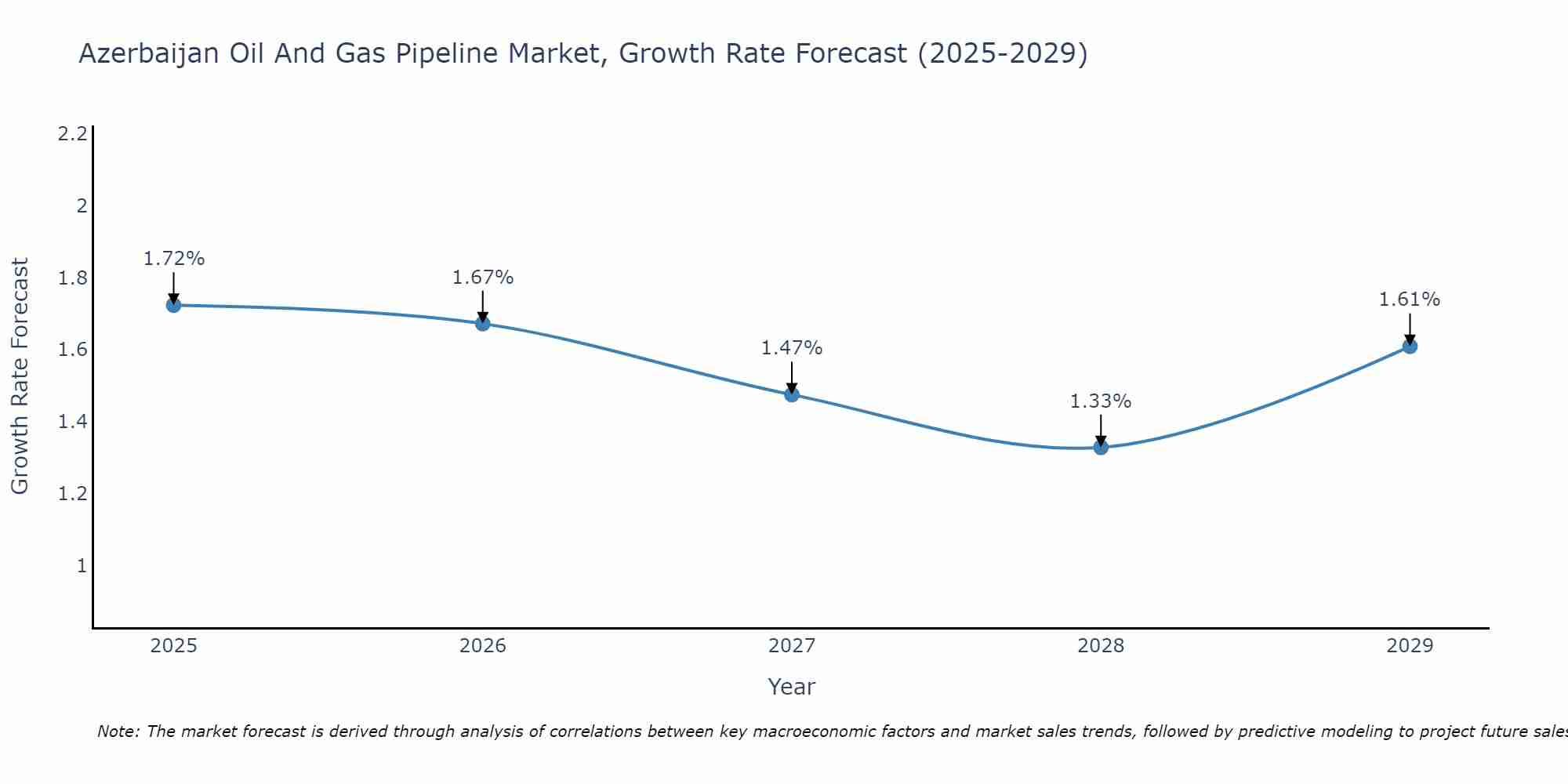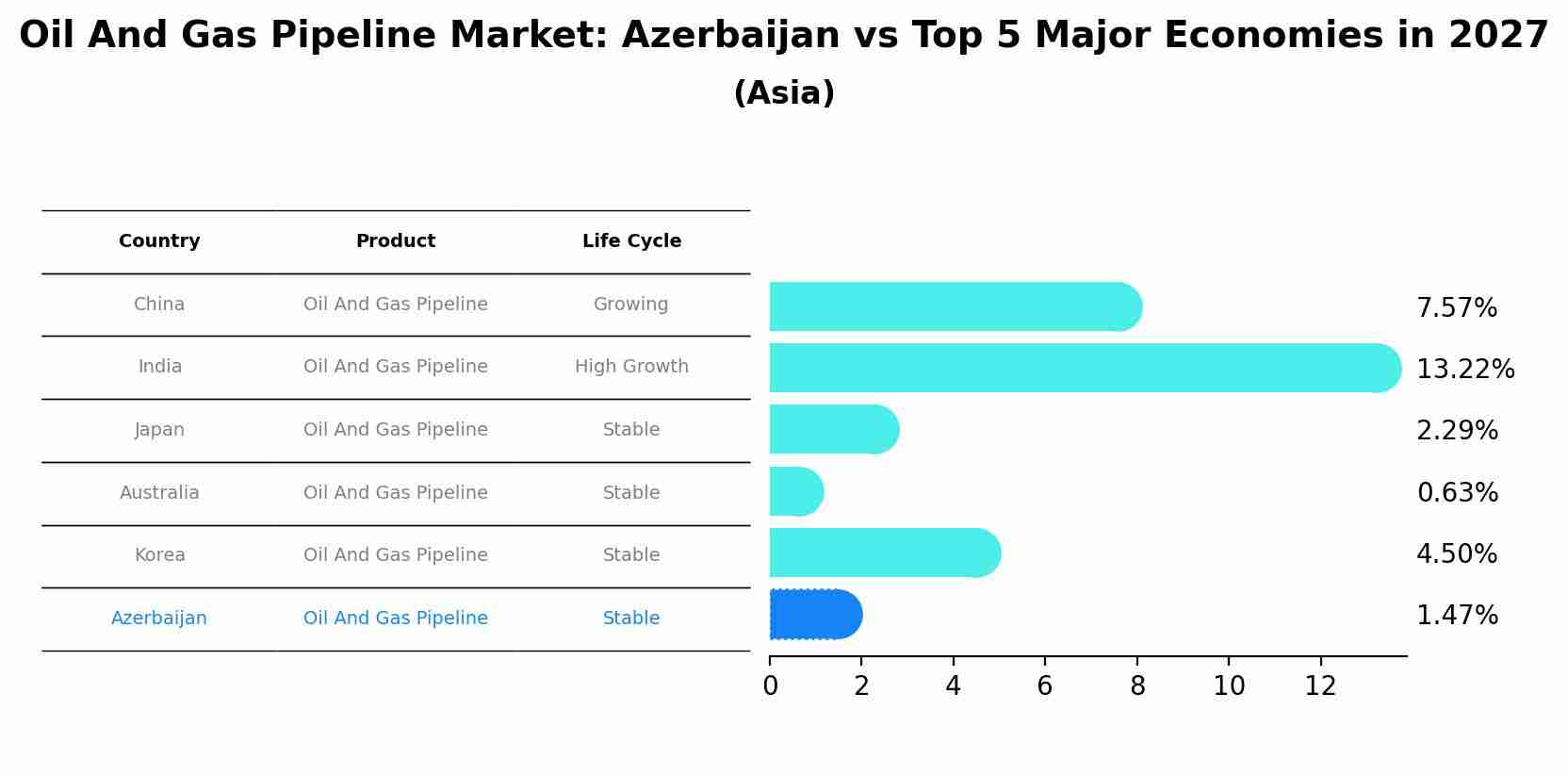Azerbaijan Oil And Gas Pipeline Market (2025-2031) Outlook | Share, Forecast, Analysis, Trends, Size, Companies, Value, Industry, Revenue & Growth
| Product Code: ETC377337 | Publication Date: Aug 2022 | Updated Date: Jul 2025 | Product Type: Market Research Report | |
| Publisher: 6Wresearch | Author: Sumit Sagar | No. of Pages: 75 | No. of Figures: 35 | No. of Tables: 20 |
Azerbaijan Oil And Gas Pipeline Market Size Growth Rate
The Azerbaijan Oil And Gas Pipeline Market is projected to witness mixed growth rate patterns during 2025 to 2029. Although the growth rate starts strong at 1.72% in 2025, it steadily loses momentum, ending at 1.61% by 2029.

Oil And Gas Pipeline Market: Azerbaijan vs Top 5 Major Economies in 2027 (Asia)
In the Asia region, the Oil And Gas Pipeline market in Azerbaijan is projected to expand at a stable growth rate of 1.47% by 2027. The largest economy is China, followed by India, Japan, Australia and South Korea.

Azerbaijan Oil And Gas Pipeline Market Synopsis
The Azerbaijan oil and gas pipeline market is a key sector in the country`s economy, dominated by the Baku-Tbilisi-Ceyhan (BTC) pipeline, which carries crude oil from the Caspian Sea to the Mediterranean. Additionally, the South Caucasus Pipeline (SCP) transports natural gas from Azerbaijan to Turkey and beyond, connecting with the Trans-Anatolian Pipeline (TANAP) and the Trans-Adriatic Pipeline (TAP) to reach European markets. These pipelines play a crucial role in Azerbaijan`s energy exports and contribute significantly to the country`s revenue. Continuous investment in pipeline infrastructure, such as the ongoing expansion of TANAP and TAP, demonstrates the country`s commitment to further developing its oil and gas transportation capabilities to meet growing demand and strengthen its position as a key player in the European energy market.
Azerbaijan Oil And Gas Pipeline Market Trends
The Azerbaijan oil and gas pipeline market is currently experiencing several key trends. One prominent trend is the ongoing expansion and modernization of existing pipelines to enhance capacity and efficiency, driven by the country`s strategic location as a key transit route for energy resources from the Caspian region to global markets. Additionally, there is a growing focus on diversifying export routes to reduce dependence on traditional transit countries, with new pipeline projects such as the Southern Gas Corridor playing a significant role in this strategy. Furthermore, advancements in technology and digitalization are being increasingly adopted to optimize pipeline operations, improve safety measures, and minimize environmental impact. Overall, the Azerbaijan oil and gas pipeline market is evolving to meet the demands of a changing energy landscape and to ensure sustainable growth in the sector.
Azerbaijan Oil And Gas Pipeline Market Challenges
In the Azerbaijan Oil and Gas Pipeline Market, there are several challenges faced by industry players. One major challenge is geopolitical instability in the region, which can impact the security and reliability of pipeline operations. Additionally, competition from other pipeline projects in neighboring countries poses a threat to Azerbaijan`s market share and revenue potential. Regulatory hurdles, environmental concerns, and the need for significant investment in infrastructure development are also key challenges faced by companies operating in this market. Furthermore, fluctuations in global oil and gas prices can directly impact the profitability of pipeline projects in Azerbaijan, making it essential for industry players to adapt to market dynamics and optimize their operations to remain competitive.
Azerbaijan Oil And Gas Pipeline Market Investment Opportunities
The Azerbaijan Oil and Gas Pipeline Market offers promising investment opportunities due to the country`s strategic location as a key transit route for energy resources from the Caspian Sea region. The development of the Southern Gas Corridor, including projects like the Baku-Tbilisi-Ceyhan Pipeline and the Trans-Anatolian Natural Gas Pipeline, presents lucrative prospects for investors looking to capitalize on the growing demand for energy transportation infrastructure. Additionally, Azerbaijan`s significant reserves of oil and gas, coupled with ongoing government initiatives to expand and modernize its pipeline network, further enhance the attractiveness of investing in this sector. With a stable political environment and supportive regulatory framework, the Azerbaijan Oil and Gas Pipeline Market is poised for continued growth and offers opportunities for long-term returns on investment.
Jordan Agar Market Government Policies
The government of Azerbaijan has implemented several key policies related to the oil and gas pipeline market to promote investment, ensure energy security, and facilitate international cooperation. These policies include the development of the Southern Gas Corridor, which aims to diversify export routes for Azerbaijani natural gas to European markets, as well as the construction of the Baku-Tbilisi-Ceyhan oil pipeline and the Baku-Tbilisi-Erzurum gas pipeline to transport oil and gas to international markets. Additionally, the government has focused on enhancing regulatory frameworks to attract foreign investment, promote transparency, and ensure the sustainable development of the oil and gas sector. These policies underscore Azerbaijan`s strategic position as a key player in the global energy market and its commitment to fostering a competitive and dynamic oil and gas pipeline industry.
Azerbaijan Oil And Gas Pipeline Market Future Outlook
The future outlook for the Azerbaijan Oil and Gas Pipeline Market appears promising, driven by the country`s strategic location as a key transit route for energy resources from the Caspian Sea region to global markets. With major projects such as the Southern Gas Corridor and the Trans-Anatolian Natural Gas Pipeline (TANAP) enhancing Azerbaijan`s role in regional energy distribution, the market is poised for sustained growth. Additionally, ongoing investments in pipeline infrastructure and the government`s commitment to expanding its energy export capabilities further bolster the market`s prospects. However, challenges such as geopolitical risks and fluctuating oil prices could impact the market`s trajectory. Overall, the Azerbaijan Oil and Gas Pipeline Market is expected to witness steady expansion in the coming years, supported by increasing energy demand and infrastructure development initiatives.
Key Highlights of the Report:
- Azerbaijan Oil And Gas Pipeline Market Outlook
- Market Size of Azerbaijan Oil And Gas Pipeline Market, 2024
- Forecast of Azerbaijan Oil And Gas Pipeline Market, 2031
- Historical Data and Forecast of Azerbaijan Oil And Gas Pipeline Revenues & Volume for the Period 2021 - 2031
- Azerbaijan Oil And Gas Pipeline Market Trend Evolution
- Azerbaijan Oil And Gas Pipeline Market Drivers and Challenges
- Azerbaijan Oil And Gas Pipeline Price Trends
- Azerbaijan Oil And Gas Pipeline Porter's Five Forces
- Azerbaijan Oil And Gas Pipeline Industry Life Cycle
- Historical Data and Forecast of Azerbaijan Oil And Gas Pipeline Market Revenues & Volume By Location of Deployment for the Period 2021 - 2031
- Historical Data and Forecast of Azerbaijan Oil And Gas Pipeline Market Revenues & Volume By Onshore for the Period 2021 - 2031
- Historical Data and Forecast of Azerbaijan Oil And Gas Pipeline Market Revenues & Volume By Offshore for the Period 2021 - 2031
- Historical Data and Forecast of Azerbaijan Oil And Gas Pipeline Market Revenues & Volume By Type for the Period 2021 - 2031
- Historical Data and Forecast of Azerbaijan Oil And Gas Pipeline Market Revenues & Volume By Crude Oil Pipeline for the Period 2021 - 2031
- Historical Data and Forecast of Azerbaijan Oil And Gas Pipeline Market Revenues & Volume By Gas Pipeline for the Period 2021 - 2031
- Azerbaijan Oil And Gas Pipeline Import Export Trade Statistics
- Market Opportunity Assessment By Location of Deployment
- Market Opportunity Assessment By Type
- Azerbaijan Oil And Gas Pipeline Top Companies Market Share
- Azerbaijan Oil And Gas Pipeline Competitive Benchmarking By Technical and Operational Parameters
- Azerbaijan Oil And Gas Pipeline Company Profiles
- Azerbaijan Oil And Gas Pipeline Key Strategic Recommendations
Frequently Asked Questions About the Market Study (FAQs):
- Single User License$ 1,995
- Department License$ 2,400
- Site License$ 3,120
- Global License$ 3,795
Search
Thought Leadership and Analyst Meet
Our Clients
Related Reports
- Canada Oil and Gas Market (2026-2032) | Share, Segmentation, Value, Industry, Trends, Forecast, Analysis, Size & Revenue, Growth, Competitive Landscape, Outlook, Companies
- Germany Breakfast Food Market (2026-2032) | Industry, Share, Growth, Size, Companies, Value, Analysis, Revenue, Trends, Forecast & Outlook
- Australia Briquette Market (2025-2031) | Growth, Size, Revenue, Forecast, Analysis, Trends, Value, Share, Industry & Companies
- Vietnam System Integrator Market (2025-2031) | Size, Companies, Analysis, Industry, Value, Forecast, Growth, Trends, Revenue & Share
- ASEAN and Thailand Brain Health Supplements Market (2025-2031) | Strategy, Consumer Insights, Analysis, Investment Trends, Opportunities, Growth, Size, Share, Industry, Revenue, Segments, Value, Segmentation, Supply, Forecast, Restraints, Outlook, Competition, Drivers, Trends, Demand, Pricing Analysis, Competitive, Strategic Insights, Companies, Challenges
- ASEAN Bearings Market (2025-2031) | Strategy, Consumer Insights, Analysis, Investment Trends, Opportunities, Growth, Size, Share, Industry, Revenue, Segments, Value, Segmentation, Supply, Forecast, Restraints, Outlook, Competition, Drivers, Trends, Demand, Pricing Analysis, Competitive, Strategic Insights, Companies, Challenges
- Europe Flooring Market (2025-2031) | Outlook, Share, Industry, Trends, Forecast, Companies, Revenue, Size, Analysis, Growth & Value
- Saudi Arabia Manlift Market (2025-2031) | Outlook, Size, Growth, Trends, Companies, Industry, Revenue, Value, Share, Forecast & Analysis
- Uganda Excavator, Crane, and Wheel Loaders Market (2025-2031) | Strategy, Consumer Insights, Analysis, Investment Trends, Opportunities, Growth, Size, Share, Industry, Revenue, Segments, Value, Segmentation, Supply, Forecast, Restraints, Outlook, Competition, Drivers, Trends, Demand, Pricing Analysis, Competitive, Strategic Insights, Companies, Challenges
- Rwanda Excavator, Crane, and Wheel Loaders Market (2025-2031) | Strategy, Consumer Insights, Analysis, Investment Trends, Opportunities, Growth, Size, Share, Industry, Revenue, Segments, Value, Segmentation, Supply, Forecast, Restraints, Outlook, Competition, Drivers, Trends, Demand, Pricing Analysis, Competitive, Strategic Insights, Companies, Challenges
Industry Events and Analyst Meet
Whitepaper
- Middle East & Africa Commercial Security Market Click here to view more.
- Middle East & Africa Fire Safety Systems & Equipment Market Click here to view more.
- GCC Drone Market Click here to view more.
- Middle East Lighting Fixture Market Click here to view more.
- GCC Physical & Perimeter Security Market Click here to view more.
6WResearch In News
- Doha a strategic location for EV manufacturing hub: IPA Qatar
- Demand for luxury TVs surging in the GCC, says Samsung
- Empowering Growth: The Thriving Journey of Bangladesh’s Cable Industry
- Demand for luxury TVs surging in the GCC, says Samsung
- Video call with a traditional healer? Once unthinkable, it’s now common in South Africa
- Intelligent Buildings To Smooth GCC’s Path To Net Zero


















